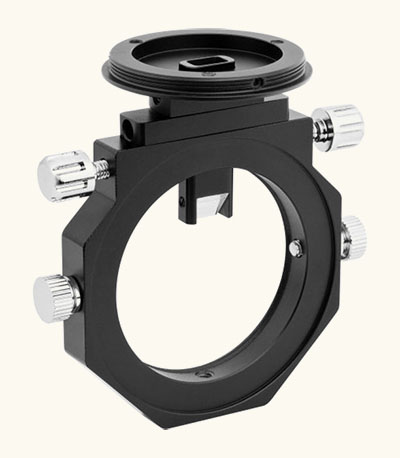Juuust a little off-center.
2020/12/30. See, I used an off-axis guider with the 10-inch R-C for a while and it worked really well. Then I used the built-in guider in the ST2000XM (also a species of off-axis guider) and that worked even better despite it being behind narrow band filters much of the time. Then I drifted off from long-focus deep-sky astrophotography (in fact, I'm still trying to get back to it) in favor of short-focus refractors. Guiding isn't needed very often with them, but when it is, a little finder-sized guide-scope does the job perfectly well. That won't do for long-exposures with long focal lengths because the guiding and the imaging telescope need to remain aligned within an arc-second or two. They won't. They simply won't. Now that I have the place out west and am looking forward to being able to use it again, it's past time to refine my gear. Who knows, maybe I'll find the enthusiasm to do more long-focus deep-sky stuff back east, too, once all the problems are ironed out.
 To that end. I've bought an Orion Thin Off-Axis Guider, henceforth, the TOAG, from another amateur astronomer via Astromart as a budget option to explore the setup. If it works out, great, and if it doesn't, I won't be out very much while I figure out exactly which OAG, if any, to adopt. To give the TOAG the best chance to succeed, I followed the advice of an Amazon reviewer and ordered socket-head 4-40 3/8" bolts from an eBay vendor. They'll replace the two lower thumbscrews in that stock photo to the left. To hold a tiny ASI120MM guide camera up top, I bought a budget Baader T2 eyepiece holder from Agena Astro. I'd've gone with the helical Baader eyepiece holder, except that those little jewels cost almost as much as I paid for the TOAG. If I recall, focus of the guide camera isn't all that critical and is really a set and forget item that you have to mess with only once per night (or once per setup for that matter). Also, I just kinda like the old-schooledness of the cheap-ass Baader product ("cheap" and "Baader" being very seldom used together). The eyepiece holder doesn't even have a compression ring, let along a clicklock grip or a helical focuser. Yes, I am cheap (cf "thrifty," "frugal"). I've spent much less for the whole kaboodle than I would have had to pay for even the least expensive OAG new. The difference is at least a day out west or half a day getting there.
To that end. I've bought an Orion Thin Off-Axis Guider, henceforth, the TOAG, from another amateur astronomer via Astromart as a budget option to explore the setup. If it works out, great, and if it doesn't, I won't be out very much while I figure out exactly which OAG, if any, to adopt. To give the TOAG the best chance to succeed, I followed the advice of an Amazon reviewer and ordered socket-head 4-40 3/8" bolts from an eBay vendor. They'll replace the two lower thumbscrews in that stock photo to the left. To hold a tiny ASI120MM guide camera up top, I bought a budget Baader T2 eyepiece holder from Agena Astro. I'd've gone with the helical Baader eyepiece holder, except that those little jewels cost almost as much as I paid for the TOAG. If I recall, focus of the guide camera isn't all that critical and is really a set and forget item that you have to mess with only once per night (or once per setup for that matter). Also, I just kinda like the old-schooledness of the cheap-ass Baader product ("cheap" and "Baader" being very seldom used together). The eyepiece holder doesn't even have a compression ring, let along a clicklock grip or a helical focuser. Yes, I am cheap (cf "thrifty," "frugal"). I've spent much less for the whole kaboodle than I would have had to pay for even the least expensive OAG new. The difference is at least a day out west or half a day getting there.
Setup notes, acquired wisdom, and breathtaking imagery tk.
:: top ::
My deep-sky photos are made with a variety of sensors and optics. Deepest images come now from a ZWO ASI1600MM Cooled Pro CMOS camera. A good many images come from an unmodded Canon 6D. Video and video extracts begin in a Canon EOS M, usually running in crop mode via Magic Lantern firmware. Telescopes include an AT10RC (a remarkable budget Ritchey-Chretien astrograph), an Orion 10" F4 Newtonian, and a pair of apochromats: a TMB92SS and a AT65EDQ. A very early Astro-Physics 5" F6 gets some use, too. So do lots of camera lenses on both the ASI1600 and the Canon 6D. A solar Frankenscope made using a 4" F10 Orion achromat and the etalon, relay optics, and focuser from a Lunt 60 feeding a small ZWO camera will see more action as the Sun comes back to life. Mounts include an iOpton SkyTracker (original model), a Losmandy G11 (non-Gemino), and an Astro-Physics Mach1 CP3. Software is PixInsight for heavy lifting and Photoshop for polish.